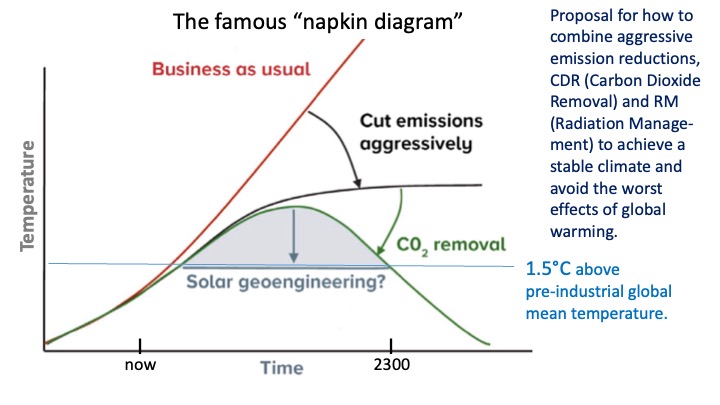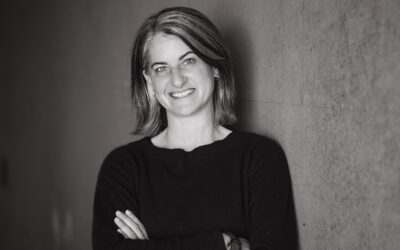An interview with atmospheric scientist David Mitchell, Ph.D., who first proposed research into the climate intervention research of cirrus cloud-thinning
The summer of 2023 was the hottest on record. Climate change fueled destructive hurricanes in Florida, more intense monsoons in India, and melted sea ice to historically low levels in the Arctic and Antarctic. Communities across the world struggled with blistering heatwaves, and vast swathes of Canada and the Eastern U.S. lived with smoke-filled skies as forests succumbed to wildfires. In fact, summer temperatures in the Northern Hemisphere were 2.59°F (or 1.44°C) above average, nearly the limit of 1.5°C above pre-industrial levels that scientists agree is necessary to limit the most extreme impacts of climate change.
With this new climate reality as the background, it’s perhaps unsurprising that the scientific community is increasingly discussing research options that can address the ever-growing problem of excess greenhouse gases in the atmosphere. Although the scientific consensus about the need for a rapid shift away from fossil fuels is solid, international progress on this front has proven slow and obstructed.
Enter the field of study known as climate intervention research (sometimes called “climate engineering” or “geoengineering”), which refers to intentional efforts to alter Earth’s atmosphere in order to counteract humanity’s unintentional climate impacts. Ideas focus on ways to reduce the excess greenhouse gases in the atmosphere (such as by pulling carbon dioxide from the air) or methods to reduce the source of the heat – solar radiation – by reflecting the sun’s energy back into space.
The research field has not been without controversy, as the idea of manipulating the global climate – even to ward off catastrophe – is a daunting proposal. But as more people face the consequences of climate change and Earth’s climate approaches “tipping points” which will ensure a drastically altered future Earth, discussions of the need for climate intervention research are becoming more open and accepted.
In 2009, DRI atmospheric scientist David Mitchell, Ph.D., first proposed research into a novel method of climate intervention known as “cirrus cloud-thinning.” Cirrus clouds are wispy, high-altitude clouds that have a warming effect on the climate as they trap heat between the cloud and the Earth’s surface. Mitchell’s idea is to dissipate these clouds by “seeding” them, which would help to concentrate their moisture into large enough ice crystals that gravity can act on them, turning them into precipitation. One study found that seeding cirrus clouds in the Arctic and Antarctic during polar winter could cool the planet by about 1. 4°C, which is enough to cancel out the current impact of all greenhouse gases produced by industrialization. Mitchell’s research is part of a larger, ongoing project at DRI looking at climate intervention techniques.
In the following interview, DRI sits down with Mitchell to discuss how perceptions of climate intervention research are changing, and the unexpected way that he came up with the idea for cirrus cloud-thinning.

Photo credit: Patrick Perkins via Unsplash
DRI: How has the conversation about climate intervention research evolved in recent years?
Mitchell: Well, it was back in 2006 that a Nobel laureate proposed the idea to mimic volcanoes by putting sulfur dioxide into the stratosphere, which would turn to sulfuric acid droplets and reflect sunlight. And that was really controversial. And then marine cloud brightening came along with John Latham, at NCAR, another well-known scientist. At the time, most people considered it as kind of non-science, like, ‘This is a wild, crazy idea, why would you ever waste your time doing this?’ In fact, in 2008 at the International Conference on Clouds and Precipitation in Cancun, one researcher was mocked for even doing that kind of research. Things have changed a whole lot since then. Now, we have the National Science Foundation with a Dear Colleague letter asking for proposals on this.
When you look at predicted future trajectories of climate change, there are these different graph curves of temperature vs time. And one curve is business as usual, so it shows how the temperature evolves if we don’t do anything. Another curve shows temperature over time if humans cut emissions. For this curve, the temperature increases for some decades, and then it levels off eventually, but it doesn’t go down. And then a third curve illustrates what happens when you’re drawing carbon dioxide or other greenhouse gases out of the atmosphere. That curve goes up and kind of peaks and then it goes back down again. But by the time it starts going back down, it might be 100 years from now. So, it shows that it’s going to take a long time to invoke negative emissions on a planetary scale. And then there’s the last curve, which shows that temperature goes up, and then it stops at, say, 1.5 degrees C above preindustrial levels, which is the limit from the Paris Agreement – and that can only be done with climate interventions. The role of climate intervention is basically to prevent us from overshooting the Paris Agreement. Eventually, global mean temperature can drop below this threshold if greenhouse gases are sufficiently removed.

DRI: Have you seen any difference between how that conversation has changed among scientists versus policymakers or the public?
Mitchell: I think the public is still waking up to the idea. And it’s become more acceptable among scientists. But still, there’s a schism in the scientific community. And it’s well illustrated in a recent paper by Jim Hanson et al. Hanson was the first scientist to sound the alarm on climate change when he testified to Congress in 1988. He’s highly regarded in the entire scientific community as a person that really changed the conversation on climate. But this new article is controversial, it’s called ‘Global Warming in the Pipeline.’ And Professor Michael Mann, another respected climate scientist at Penn State, issued a strong rebuttal against this article.
At the heart of their disagreement is whether warming will stop if humans put the brakes on greenhouse gas emissions. Mann believes this, but Hansen doesn’t. Hansen claims that because humans have created a lot of atmospheric aerosols through various sources of pollution – which naturally reflect sunlight back into space – that we’ve seen a cooling effect. But pollution reduction efforts in recent years are bringing these aerosol levels down, which is enhancing global warming. This is partly why Hansen says that humanity won’t be able to control climate change without climate engineering. Those are scientific debates that don’t normally reach the public.
DRI: How did the idea that cirrus cloud-thinning could help mitigate the impacts of climate change first occur to you?
Mitchell: The idea first came to me in a dream. I was doing research at the National Center for Atmospheric Research while I was on sabbatical, and when I got back to Reno, I had this dream about how all my research findings could be repackaged into this idea. When I woke up, the idea was just present, which seemed kind of unusual – I don’t normally have dreams like this. So, I felt like I should test it out. I wrote an abstract and sent it to the American Geophysical Union for their fall meeting, and later received a phone call from an AGU official inviting me to attend an AGU press conference on climate intervention research. To me, it was like a sign that I should continue this line of research. At first, I had thought that maybe the idea was pretty weird, and people would just laugh at it. But they didn’t. Whenever I did talk about it, it had a good reception. So, I just kept going.
DRI: How was the idea originally received? And how has it changed?
Mitchell: The scientific community showed a lot of interest. I wrote a paper on it in 2009, and then a book chapter in 2011, and they both got a lot of attention. And then at a 2012 conference known as the International Conference on Clouds and Precipitation, in Leipzig, Germany, there was a special panel discussion devoted to how clouds could be used to modify global warming. We worked with the conference organizers to conduct a survey to gauge everyone’s opinion about whether research should be done on this topic, and I think roughly half the community were in favor of the research.
DRI: What is the number one most important thing for people to understand about this idea?
Mitchell: The first is that it’s not a substitute for emissions reduction – most scientists agree that first and foremost, we have to reduce emissions or else it’s ridiculous to use this kind of thinking. Also, achieving negative emissions through the reduction of greenhouse gases is very important to do. It appears to me that scientists that are interested in this type of research on climate intervention generally agree that we need to do emissions reduction and negative emissions, but we also might need climate intervention to prevent tipping points in the climate system. There’s a lot of uncertainty about these tipping points, like how much warming would cause them to tip. But the way I look at it, just because there’s uncertainty doesn’t mean you want to allow it to get warmer, because you’re playing Russian roulette with the Earth’s climate system. If we cross the tipping point, it’s going to be really hard to get the climate to cool down again—we’ll be stuck in a warmer climate then. So, we need to be cautious about it. We might want to consider climate intervention to make sure we don’t surpass 1.5 degrees Celsius above pre-industrial levels. Where we draw the line is probably for the policy people to decide.
DRI: What do you see as scientists’ responsibility, moral, professional, or otherwise, for helping humanity understand and/or address climate change?
Michell: I think that scientists have already done a fairly good job of helping humanity understand climate change. But maybe the scientific community first needs to come together with one voice to say how we should proceed. Because right now, I empathize with the public in being confused, because we have people like Michael Mann saying one thing, and Jim Hanson saying a different thing. How is the public supposed to sort all that out? The arguments between the two points of view are very technical.
DRI: In 1987, governments around the world came together in Montreal to address the growing hole in the ozone layer. What do you think is different between this example and how we’re addressing climate change now?
Mitchell: Well, they’re two different eras, as you might say. The Montreal Protocol quickly addressed the ozone problem, because the research showed really clean chemical reactions on how ozone is being destroyed by chlorofluorocarbons (CFCs). The science was pretty compelling. So, most scientists could agree on this narrow set of reactions. But the climate problem is very multifaceted, there are so many different things going on. But another thing is that back during the Montreal Protocol, there was less disinformation and misinformation circulating, and we’re under a completely different information climate now. So, it’s really hard for people to make sense of things.
DRI: Are there obstacles to continuing your research on climate intervention strategies?
Mitchell: Funding is the main obstacle. Governments need to make up their mind about whether this is important and warrants public funding. The research isn’t going to make progress very fast with the current resources designated for it.
That being said, the National Science Foundation recently sent a “Dear Colleague Letter” out saying that they would like to receive proposals on climate intervention research.
DRI: When you think about climate change, do you see reasons to feel hopeful about the future?
Mitchell: In a way, although maybe it’s wishful thinking. One might hope that the people of the world would be convinced at some point that climate change is real. And that to solve the problem of climate change, it’ll take cooperation among nations. So far, we haven’t been doing too well with these United Nations Conference of the Party (COP) meetings around the world, as it’s hard to get national leaders to agree on things. But if climate change got bad enough, maybe we would start working together more – that’s a reason for hope. In a way, it’s too bad that we have to have a disaster forced upon us to possibly cooperate.
Some people say we live in a post-truth world where objective facts or objective reality aren’t considered as real. And if the world finally accepts climate change is real, maybe we’ll get back on track again, where we’re no longer living in a post-truth world. And that would be big progress.


